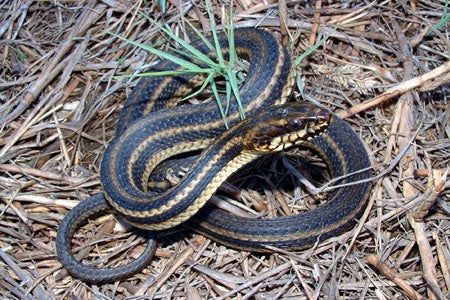SCIENTIFIC NAME:
Nerodia clarkii
OTHER NAMES:
Salt marsh snake, Clarke’s water snake, bay moccasin
STATUS:
Uncommon to fairly common in suitable habitat, which is limited. This coastal water snake has specialized habitat requirements and has declined due to destruction and degredation of salt marshes in both Baldwin and Mobile counties. Formerly considered a subspecies of N. fasciata. HIGH CONSERVATION CONCERN.
DESCRIPTION:
Gulf salt marsh snakes are medium-sized water snakes reaching a maximum length of 36 inches, though most individuals encountered are 30 inches or less in length. This member of the genus Nerodia is unusual in that it is the only striped member of the group. Four stripes highlight the upper parts of the body. Two stripes typically are brown while two stripes are lighter tan or yellowish in color. The gulf salt marsh snake’s belly is darker in color, but has a conspicuous light stripe down the center. These snakes have keeled scales.
DISTRIBUTION:
Three subspecies of salt marsh snakes are recognized. The Atlantic salt marsh snake (Nerodia clarkii taeniata) is found only in two counties along Florida’s eastern coastline. The mangrove salt marsh snake (Nerodia clarkii compressicauda) occurs from the central gulf coast of Florida south throughout the keys and north to central Florida along the Atlantic coast. The gulf salt marsh snake is found from the central Gulf coast of Florida north and westward along the Gulf coast to south Texas.
HABITAT:
Gulf salt marsh snakes inhabit coastal salt marshes and brackish estuaries. They usually are not found in freshwater environments.
FEEDING HABITS:
Gulf salt marsh snakes prey on small fish and invertebrates which often are trapped in puddles created by outgoing tides.
LIFE HISTORY AND ECOLOGY:
Gulf salt marsh snakes live in areas where freshwater is unavailable; therefore, they obtain water from their prey. Rainwater may also be utilized as well. These snakes are active primarily at night, and hide in wrack lines and vegetation during the day. Gulf salt marsh snakes usually give birth to approximately ten live young, but litters may range from three to nearly twenty. Young are similar in appearance to adults, but may be more brightly colored.
The gulf salt marsh snake is of moderate conservation concern in Alabama due to its restrictive habitat requirements.
REFERENCES:
Conant, R. and J. T. Collins. 1991. A field guide to the reptiles and amphibians of eastern and central North America. Houghton Mifflin Company, Boston. 450 pp.
Gibbons, J.W. and M.E. Dorcas. 2004. North American Watersnakes: A Natural History. University of Oklahoma Press, Norman. 438 pp.
Mirarchi, R.E., ed. 2004. Alabama wildlife. Volume 1. A checklist of vertebrates and selected invertebrates: Aquatic mollusks, fishes, amphibians, reptile, birds, and mammals. The University of Alabama Press, Tuscaloosa. 209 pp.
Mount, R. H., ed. 1986. Vertebrate animals of Alabama in need of special attention. Alabama Agricultural Experimental Station, Auburn University, Auburn. 124 pp.
AUTHOR:
Roger Clay, Wildlife Biologist, Alabama Division of Wildlfie and Freshwater Fisheries






